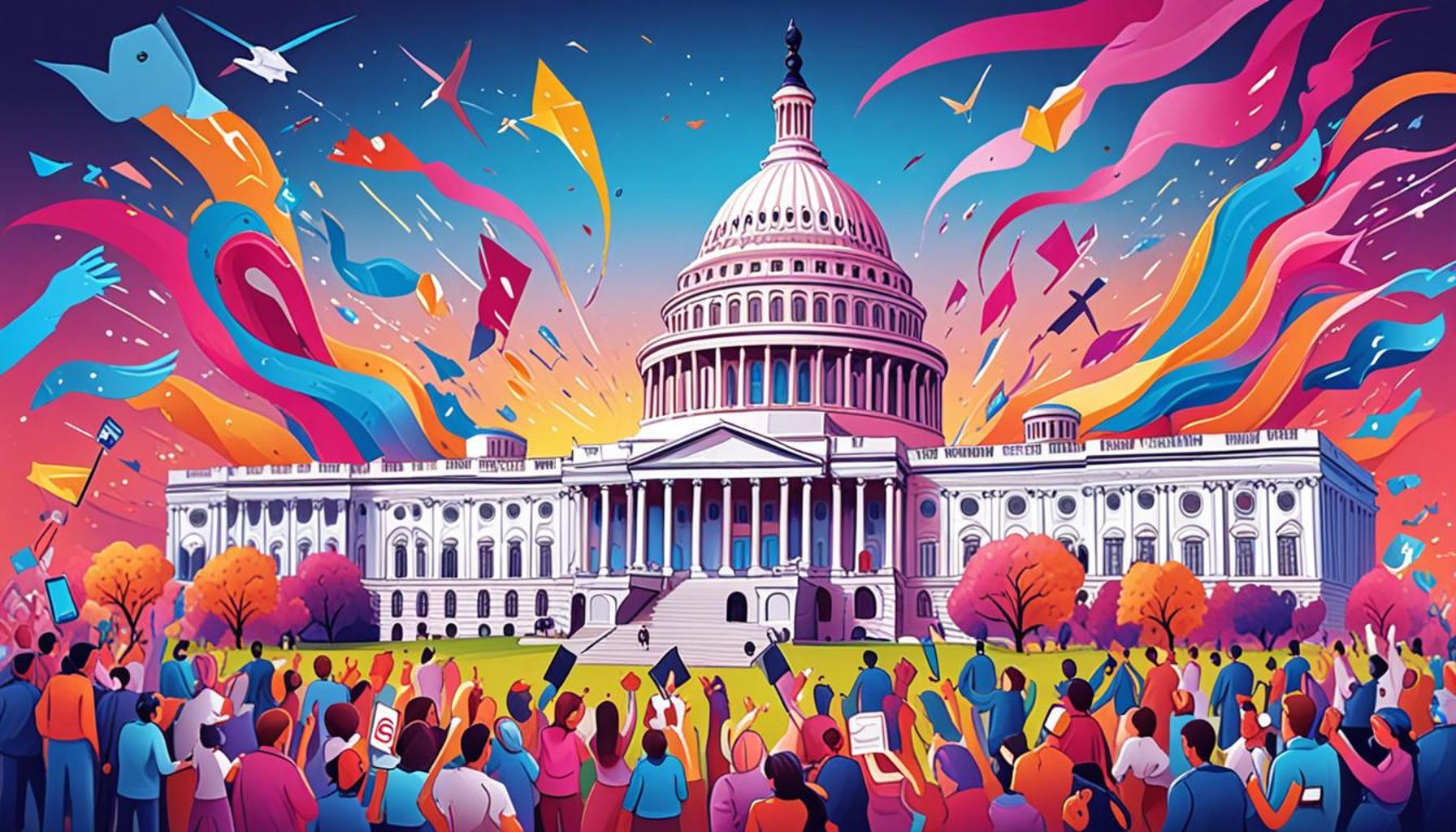The Importance of Digital Outreach to Increase Awareness of Government Benefits

Unlocking Access to Vital Resources
In today’s digital age, the gap between government services and the citizens who need them can often seem insurmountable. Digital outreach plays a crucial role in bridging this divide, ensuring that communities are informed about the benefits available to them. By leveraging technology, we can enhance the visibility, accessibility, and understanding of government programs that significantly impact people’s lives.
Consider the vast array of benefits offered to citizens:
- Healthcare support programs like Medicaid and CHIP (Children’s Health Insurance Program) provide essential medical coverage for millions of low-income families and children across the nation.
- Food assistance through SNAP (Supplemental Nutrition Assistance Program) combats hunger by providing assistance to eligible individuals, thereby ensuring that nutritional needs are met.
- Housing assistance programs aim to support low-income families, veterans, and the elderly, helping them secure stable homes through subsidized rents and public housing initiatives.
- Unemployment benefits serve as a financial safety net, allowing individuals facing job loss to maintain their livelihoods during challenging economic conditions.
Despite these resources, many eligible individuals remain unaware of their existence. Statistics reveal that approximately 30% of those qualified for food assistance do not participate in SNAP, which illustrates the potential for improvement in outreach efforts. This issue is particularly pronounced among vulnerable populations such as minorities, the elderly, and people with disabilities, who may face additional barriers to accessing these critical services.
Implementing effective digital outreach strategies is essential. Key benefits include:
- Targeted communication that reaches specific demographics via tailored messaging can significantly increase engagement and participation rates. For instance, social media campaigns can specifically address younger audiences, while email newsletters can cater to older individuals.
- Engaging content that educates the public about their options not only raises awareness but also empowers citizens to take action. Infographics, videos, and interactive tools can simplify complex information, making it more digestible.
- Streamlined access to resources via user-friendly websites and social media platforms allows citizens to find the information they need comfortably. The use of mobile applications can also facilitate easier access, especially for those with limited internet access.
As we explore the significance of digital outreach, it becomes clear that enhancing awareness of government benefits is not just a technological challenge, but a societal imperative. Engaging communities through these digital channels not only informs citizens about their rights and resources but also encourages civic participation. Such proactive engagement has the potential to transform lives, uplift entire populations, and foster a sense of belonging within the fabric of society.
In the end, unlocking access to vital resources is a shared responsibility between government agencies, community organizations, and the public. By working collaboratively, we can create a more informed citizenry and ensure that everyone has the opportunity to benefit from the programs designed to support them.
RECOMMENDED: Check out this similar article
Bridging the Information Gap
One of the most pressing challenges in the realm of government benefits is the information gap that leaves many eligible citizens in the dark. A significant number of individuals who qualify for programs such as Medicaid, SNAP, and housing assistance fail to enroll simply because they are unaware of the resources available. This lack of awareness translates into missed opportunities for support and empowerment, affecting not only the individuals and families in need but also the broader community and economy.
A recent study by the U.S. Department of Agriculture indicated that approximately 2.5 million eligible children do not receive benefits from the SNAP program, highlighting the critical need for enhanced digital outreach. The repercussions of underutilization extend beyond food security; they cascade into health disparities, economic instability, and reduced overall quality of life for countless families across America. In this context, increasing awareness through digital platforms becomes not just beneficial, but necessary.
Digital outreach can transform the landscape of government communication by employing a few key strategies, which include:
- Social Media Engagement: Platforms like Facebook, Twitter, and Instagram are valuable tools for reaching a diverse audience. By crafting engaging posts that resonate with specific demographics, government programs can effectively disseminate important information and encourage program participation.
- SEO-Optimized Content: Utilizing search engine optimization (SEO) techniques ensures that information about government benefits is easily discoverable online. When potential beneficiaries search for assistance, well-tailed content can lead them directly to the resources they need.
- Community-Based Online Workshops: Hosting virtual sessions aimed at educating the public about various programs fosters a direct line of communication. These workshops can demystify the application process and address common concerns, providing a platform for citizens to ask questions and gain clarity.
Understanding the specific barriers faced by certain communities is critical when designing these strategies. For example, minority groups may not have consistent access to reliable internet services, while elderly individuals might feel overwhelmed by technology. To address these disparities, outreach efforts should include provisions for multilingual resources and partnerships with community organizations that can help disseminate information through traditional means.
As we delve further into the importance of digital outreach, it’s clear that this arena has the potential to redefine how citizens interact with government services. Efforts to raise awareness about available benefits can empower individuals to not only take advantage of the support offered but also advocate for themselves and their families. When citizens are equipped with knowledge, they become active participants in both their own lives and the civic process, fostering a society where support is sought and received more equitably.
| Advantage | Description |
|---|---|
| Increased Accessibility | Digital outreach allows for greater access to information regarding government benefits. Citizens can easily navigate resources online, ensuring they are informed about their available options. |
| Targeted Messaging | Through analytics, outreach strategies can be tailored to specific demographics, ensuring that relevant information regarding government assistance programs reaches the intended audience effectively. |
| Community Engagement | Digital platforms facilitate engagement with communities, allowing for real-time feedback and discussions, which can further enhance understanding and awareness of available benefits. |
| Cost-Effective Solutions | Utilizing digital strategies for outreach can significantly lower costs compared to traditional methods, making it easier for government entities to disseminate information widely and efficiently. |
Digital outreach is not just a modern solution; it is a method designed to empower citizens by fostering significant awareness of government benefits. When people are well-informed, they are more likely to engage with and utilize the resources available to them. As more individuals take advantage of these benefits, communities experience stronger social safety nets, ultimately benefiting society as a whole. Furthermore, with the rise of social media, governments can harness these platforms to enhance communication and outreach efforts. Engaging content can be shared, prompting discussions and leading to a more informed populace. Overall, the myriad advantages of digital outreach are integral to increasing awareness and understanding of government benefits, ensuring that vital information is accessible to everyone.
SEE ALSO: Click here to read another article
Maximizing Impact Through Targeted Outreach
To fully leverage the potential of digital outreach for government benefits, it is essential to adopt a targeted approach that considers the diverse needs of various populations. This means more than just broadcasting information; it involves understanding specific community characteristics, preferences, and accessibility challenges. Tailoring outreach efforts can significantly enhance the effectiveness of information dissemination, ensuring that it reaches those who need it most.
For instance, data analytics can play a pivotal role in identifying which demographics are most likely to benefit from specific programs. By analyzing trends and user interactions online, government agencies can create targeted campaigns aimed at demographics that show lower participation rates—like single parents, low-income families, or seniors. In this way, outreach can be adjusted to feature testimonials from relatable individuals or case studies that demonstrate real-life success stories involving the benefits.
Another important factor to consider is the expansion of mobile-friendly options. With approximately 85% of American adults owning smartphones, it’s vital that information regarding government benefits is easily accessible via mobile devices. Government websites and applications must be designed to be mobile-responsive, allowing users to navigate resources seamlessly, even on smaller screens. This focus on mobile accessibility will enhance user experience and, consequently, the likelihood of engagement with available services.
Engagement initiatives can also benefit from the use of influencer partnerships within communities. Local leaders, activists, and respected figures can amplify messaging, lending authenticity and trust to government campaigns. By utilizing their platforms to share information about government benefits, these influencers can effectively bridge the gap between the community and government resources, thereby encouraging broader participation.
Besides utilizing social media influencers, collaboration with nonprofit organizations and local businesses can pool resources and knowledge, allowing for community-based outreach strategies. For instance, libraries, food banks, and health clinics can serve as trusted hubs where community members might access information on benefits. These organizations often have established relationships with the populations they serve, making them invaluable partners in a wider outreach strategy.
Moreover, incorporating feedback mechanisms can help in refining outreach strategies over time. By soliciting user feedback regarding the accessibility and clarity of communication regarding benefits, agencies can adapt their methods, ensuring that future outreach initiatives are responsive to the needs and preferences of actual users. Such continuous improvement is essential for building trust and ensuring that messages resonate effectively.
Data-driven decision-making is crucial in this landscape. By regularly evaluating the impact of digital outreach efforts—whether through social media engagement metrics, website traffic analysis, or participatory feedback surveys—government agencies can fine-tune their strategies and make informed decisions about where to invest resources for maximum outreach efficiency.
In this digital age, with increasing reliance on technology for information retrieval, targeted digital outreach stands out as the cornerstone for increasing awareness of government benefits. By implementing diverse and adaptable strategies, it is possible to reach every corner of the community, ensuring that eligible individuals are informed and empowered to access the support they need. As the data unfolds, the importance of these initiatives becomes increasingly clear, and the potential for transformation solidifies.
YOU MAY ALSO LIKE: Read read another article
Conclusion: Empowering Communities Through Digital Outreach
In conclusion, the effectiveness of digital outreach in increasing awareness of government benefits cannot be overstated. As we navigate an increasingly digital world, embracing targeted strategies is fundamental for maximizing outreach efforts. By understanding the diverse needs and preferences of various communities, government agencies can tailor their messaging to resonate with those who are often unaware of the resources available to them.
Moreover, leveraging data analytics and mobile technology is crucial in reaching underrepresented demographics. With most individuals accessing information via smartphones, ensuring that government resources are mobile-friendly is not just beneficial; it is essential for driving engagement. Partnering with local influencers and nonprofit organizations further enriches outreach methods, allowing agencies to utilize trusted community figures who can effectively communicate the importance of available programs.
Feedback mechanisms and a focus on continuous improvement will further empower agencies to refine their initiatives, fostering a culture of trust and reliability. Ultimately, as government outreach evolves in response to the digital age, it presents a unique opportunity to close the gap between resources and those in need.
As we look toward the future, prioritizing digital outreach not only increases participation in essential programs but also contributes to building a more informed, capable, and connected society. Transformative change is within reach when governments harness the power of technology to bridge the divide, ensuring every eligible individual has access to the benefits they deserve.



